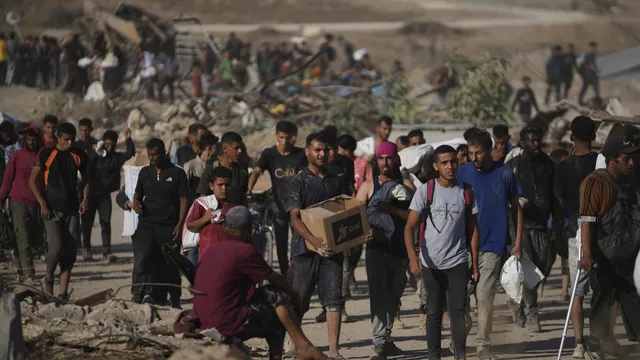
Israeli forces kill dozens seeking food aid in Gaza
2025-06-28 00:44- Israeli forces reportedly opened fire on large crowds in Gaza as they sought food aid, resulting in numerous deaths.
- Human rights groups and UN agencies have condemned the impact of the Israeli military's actions on civilians attempting to access aid.
- The series of violent incidents highlights the worsening humanitarian crisis in Gaza, with a significant number of casualties reported.
Express your sentiment!
Insights
In Gaza, Israeli forces opened fire on crowds of people waiting for aid trucks, resulting in multiple fatalities. On a recent day, at least 25 individuals were reported killed as they approached food distribution sites in central Gaza. Witnesses described scenes of chaos and violence, with military drones and tanks targeting civilians who were unarmed and simply seeking food to survive. The Gaza health ministry has reported that hundreds of deaths have occurred in similar circumstances since the onset of the Israeli campaign following the attacks by Hamas in October 2023. Those seeking assistance have frequently faced deadly situations, raising significant concerns about the humanitarian impact of the military operations. The aid distribution efforts are now heavily scrutinized, particularly regarding the methods employed by the Gaza Humanitarian Foundation, which refused to acknowledge the severity of the incidents. The UN agencies have condemned the operations as ineffective and dangerous, stating that more lives are being lost than saved due to the current system. This ongoing conflict has resulted in overwhelming casualties, with various reports estimating that over 55,000 Palestinians have been killed, of whom many are women and children. Such numbers signal a deepening humanitarian crisis, as the region struggles to meet basic needs amidst the war.
Contexts
The Israeli-Palestinian conflict has been a focal point of geopolitical tension and violence in the Middle East for decades, rooted in a complex history of territorial disputes, religious significance, and competing national identities. The primary conflict arose in the late 19th and early 20th centuries with the rise of nationalist movements among both Jews and Arabs. The establishment of the State of Israel in 1948, following the horror of the Holocaust, marked a significant turning point, leading to the first Arab-Israeli war and the creation of a refugee crisis that resonates to this day. Central to the conflict is the status of Jerusalem, a city of profound significance to both Israelis and Palestinians, as well as issues surrounding borders, security, and the rights of displaced peoples. Over the years, numerous peace efforts, such as the Oslo Accords in the 1990s, aimed to establish a framework for resolving the conflict, yet these negotiations have largely faltered. Issues such as the expansion of Israeli settlements in the West Bank, the blockade of Gaza, and acts of violence from both sides have effectively hindered progress, leading to cycles of conflict and retribution. Palestinian territories are often characterized by significant economic hardship, restricted movement, and a lack of political autonomy, which fuel discontent and exacerbate tensions. Conversely, many Israelis cite security concerns stemming from past attacks and ongoing threats from militant groups as justification for stringent security measures and military operations. Recent developments in the region have seen shifts in international attitudes and alliances, with some Arab nations normalizing relations with Israel while others continue to advocate fiercely for Palestinian rights. This evolving landscape complicates the prospects for a peaceful solution, as differing narratives and geopolitical interests lead to divergent approaches among stakeholders. Additionally, leadership within both Israeli and Palestinian communities poses challenges; divisions among Palestinian factions, specifically between Fatah and Hamas, complicate the implementation of a unified negotiation strategy and response to external pressures. In conclusion, the Israeli-Palestinian conflict remains entrenched in a historical context filled with suffering, loss, and deep-seated grievances. While the path to peace is laden with obstacles, it remains essential for both parties and the international community to engage in dialogue aimed at finding a lasting resolution. Fostering an environment conducive to negotiations, addressing humanitarian needs, and adhering to principles of justice and coexistence will be critical in moving towards a solution that honors the aspirations of both peoples.